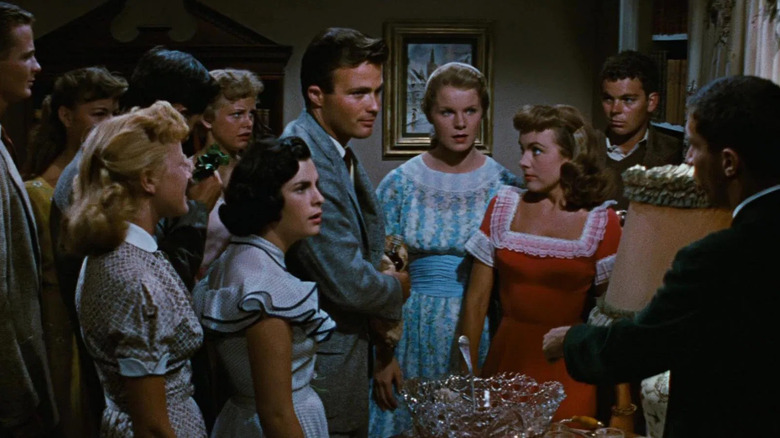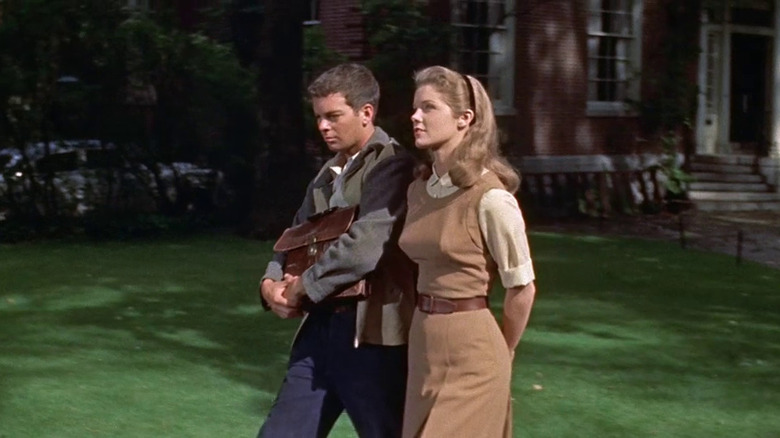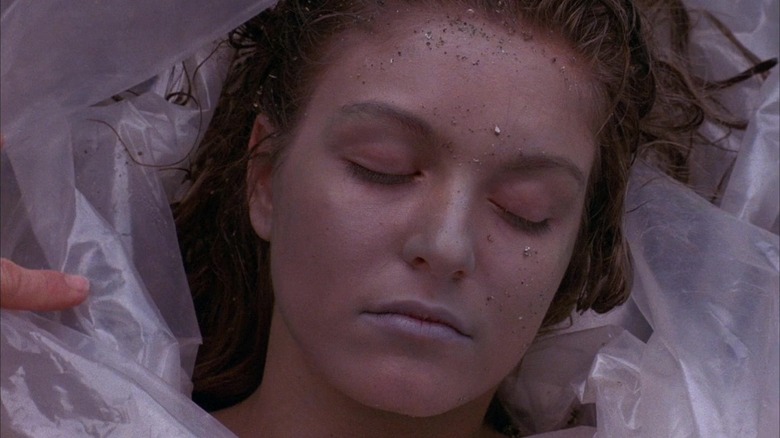David Lynch's Twin Peaks Was Inspired By A Controversial Oscar-Nominated Movie
The late David Lynch was born in Missoula, Montana, in 1946 and raised by a father who worked for the Department of Agriculture. He spent his childhood driving through the woods with his dad and settling in placid, 1950s suburbs in towns such as Spokane, Washington, Boise, Idaho, and Durham, North Carolina. His childhood provided him with an idealized portrait of what we might now think of as "classic Americana." One can see elements of Lynch's upbringing in his films, such as "Blue Velvet," and TV shows, such as "Twin Peaks."
Of course, "Blue Velvet" and "Twin Peaks," as one can immediately note, are harsh admonitions of 1950s Americana. "Blue Velvet" may take place in a placid world of neatly cut lawns and picket fences, but there is rot, crime, and kinky sex just underneath the surface. The town of Twin Peaks may be full of sweet, quirky, coffee-drinking-and-pie-eating locals, but there is abuse, incest, drugs, and underage sex work in every third house. Lynch may have been raised in typical suburban homes, but he knew there was repression, crime, scandal, and sadness lurking around every corner.
The pop media of the 1950s wasn't always as placid as its white suburbs. Unexperienced critics might assume that all 1950s media was square and uninvolving, a sea of "Leave it to Beavers" and "Ozzie and Harriets." Those familiar with some of the Oscar-nominated melodramas from the decade can tell you that filmmakers were constantly trying to push the envelope, tackling the abuse, racism, sex, and horror that lurked inside the suburbs; just watch Elia Kazan's "A Streetcar Named Desire" or Douglas Sirk's "Written on the Wind." Heck, watch Ed Wood's "Glen or Glenda," a strikingly open-minded, progressive film about the trans experience. If you're a David Lynch fan, definitely watch Mark Robson's 1957 Best Picture nominee "Peyton Place." Lynch and his "Twin Peaks" co-creator, Mark Frost, admitted that "Peyton Place" was a primary influence on their show. They said so in an oral history on the fansite Our Town.
Twin Peaks was heavily influenced by 1957 Best Picture nominee Peyton Place
"Peyton Place" was a giant hit when it released, making almost $26 million on its $2.2 million budget. It boasts a large cast of players and subject matter that stood at the cutting edge of controversy. The film takes place in a fictional city in New England, where everything seems peaceful and well-organized on the surface but is sloppy, horrible, and dark just underneath. It mostly concerns the plight of the middle-class MacKenzie family and the impoverished Cross family. The daughters of both families, Allison MacKenzie (Diane Varsi) and Selena Cross (Hope Lange), are best friends.
Allison's life is insulated by her wealth and a lot of the film is devoted to her romantic relationship with the nerdy Norman (Russ Tamblyn). She and Norman have very frank discussions of sex and how it works into their lives. Allison is also friends with Betty (Terry Moore), who has acquired — through the judgmental eyes of the adults of Peyton Place — a "floozy" reputation. The father of her kinda-dumb boyfriend, Rodney (Barry Coe), doesn't like Betty. Meanwhile, Selena lives with an alcoholic stepfather named Lucas (Arthur Kennedy). Early in the film, Lucas sexually assaults Selena and impregnates her. One of the central drama's of "Peyton Place" is what Selena needs to do to survive the horrible ordeal. A very understanding doctor (Lloyd Nolan) learns the truth, is horrified, and persuades a written confession out of Lucas, forcing him to leave town forever. The doctor understands that, in Peyton Place, Selena's life will be further ruined if news of her assault leaked. Lucas, he knows, will be fine.
Injustice, assault, sexism, and death are underneath everything. One might be able to see from the description that "Twin Peaks" owes a heavy debt to "Peyton Place." Laura Palmer (Sheryl Lee) is clearly a modern spin on Selena, the high school girl with dark secrets, the young woman secretly being assaulted by a family member.
Laura Palmer was clearly modeled on Selena from Peyton Place
Lynch and Frost, however, martyr Laura Palmer so Agent Dale Cooper (Kyle MacLachlan) can start to see under the surface. Her death is used to wedge open the town and shed sunlight onto the insects therein. Laura wouldn't be given a voice and agency, however, until the follow-up prequel movie, "Twin Peaks: Fire Walk with Me," in 1992.
In the oral history, Lynch's agent, Tony Krantz, said that he, Lynch, and Frost gathered in a small screening room in Beverly Hills and took in a screening of "Peyton Place" when they were brainstorming ideas for a TV series back in 1989. Lynch and Frost said they liked the idea of a small-town drama and Frost said he "wanted to tell a sort of Dickensian story about multiple lives in a contained area that could sort of go on perpetually. It's a classic staple of television." Krantz recalled watching "Peyton Place" with Frost and Lynch and subsequently hearing them develop their initial ideas for "Twin Peaks," originally to be called "Northwest Passage."
Weirdly, Frost and Krantz were more keen on the idea than Lynch, who said "the idea of a small-town thing, Tony got all hopped up about that. I was sort of lukewarm, and so was Mark, but we just decided to humor him." He continued, in his usual abstract fashion: "A continuing story is a beautiful thing to me, and mystery is a beautiful thing to me, so if you have a continuing mystery, it's so beautiful. And you can go deeper and deeper into a story and discover so many things." Frost liked the "secret life of the girl next door" angle, saying "as we figured out who she was and realized that she was dead, everything flowed from there." And lo, "Twin Peaks" was born.


